How to Maintain a Sump Pump
9/24/2018 (Permalink)
A sump pump is a handy tool, especially in Towson North, MD, that helps to prevent flooding; however, it does require a certain level of pump maintenance to ensure that it is always operating to its full capability. To maintain your pump, there are six areas that you should check before severe weather hits.
1. GFCI
Every so often, it is important to check that the Ground Fault Circuit Interrupter (GFCI) that your unit is plugged into is properly working. To ensure the outlet is working correctly simply plug any electronic into it and make sure that you can power it on.
2. Discharge Pipe
As an essential part of any pump operation, the discharge pipe can become clogged by debris, like dirt and gravel, so it is necessary to inspect the pipe and clean out any blockages.
3. Intake Screen
Like the discharge pipe, the intake screen of your pump can become clogged with debris and will need to be cleaned once in a while to ensure the free flow of water.
4. Float Component
The float mechanism in the sump pump housing can become obstructed, which means that it will not activate the pump mechanism. This area of the pump should be inspected regularly for debris to ensure proper operation.
5. Pump
The pump mechanism can be tested by merely pouring a bucket of water into the pump basin. As the float rises in the water, it should activate the pump. If the pump does not activate and there is no debris, you may want to call in a professional to inspect it.
6. Battery Backup
Many pumps come with a battery backup. If your pump is one of these types, then every few years, 2 to 3, you will want to replace the battery.
A sump pump, while an essential tool in the prevention of home flooding, is not without its quirks, and it is normal to have to perform routine maintenance to keep it functioning as intended.





 24/7 Emergency Service
24/7 Emergency Service
